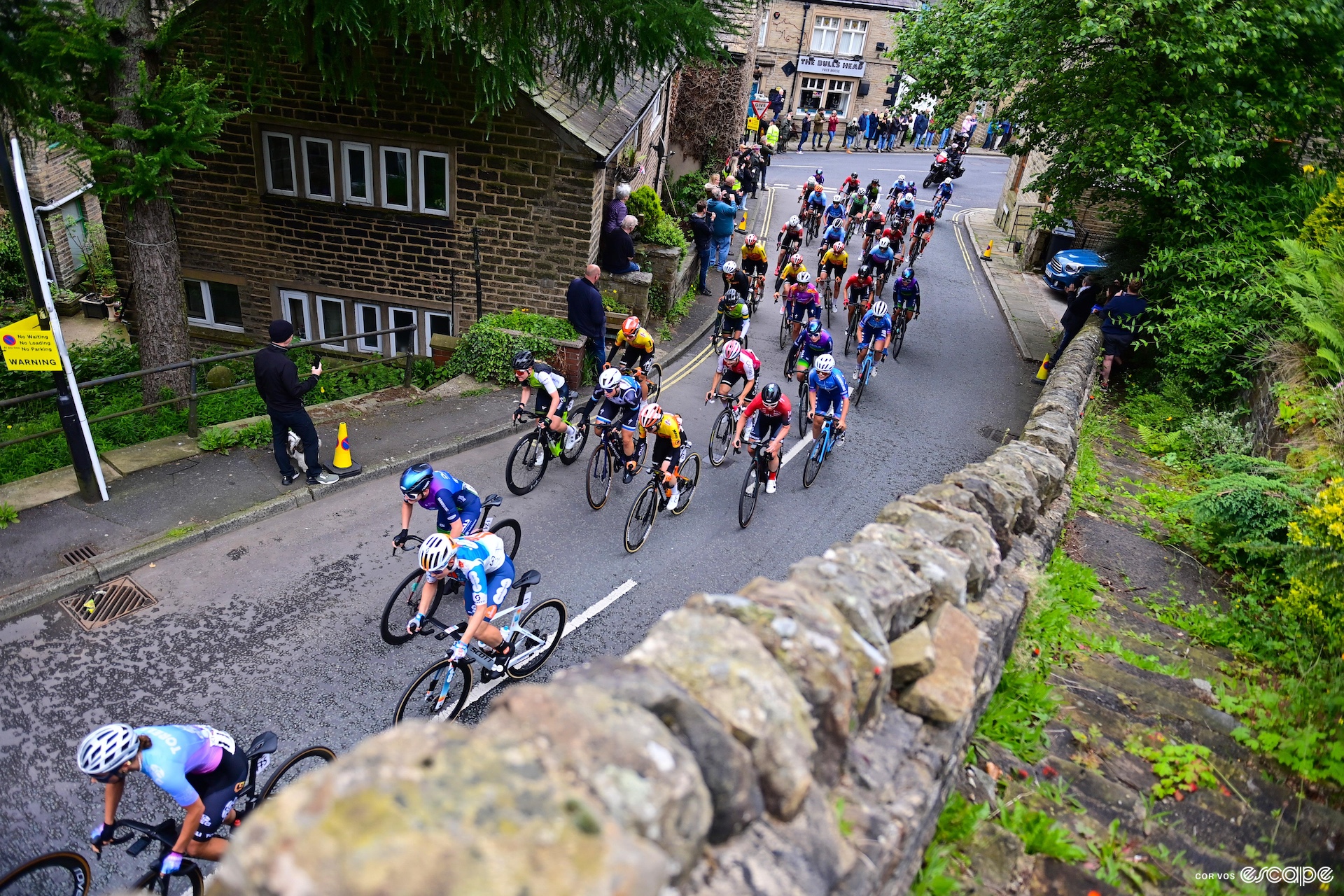A lot was said during the spring that the SD Worx-Protime dominance was behind us, but after the Dutch team won the last five WorldTour stage races, it seems they are still going to stay firmly on top of the charts this season. Can the strong turnout at the Tour de Suisse finally unseat SD Worx-Protime? They’ll have to go through Demi Vollering first.
There was a lot to take away from the first edition of Volta a Catalunya.
The three-day race in Spain played host to a handful of the peloton’s top riders, more Women’s WorldTour teams than the WWT-rated Tour of Britain, and saw slightly more dynamic racing than the SD Worx-Protime show that dominated the race formerly known as The Women’s Tour.
AG Insurance-Soudal and Visma-Lease a Bike were the two teams that controlled the first stage, and their hard work paid off. The stage came down to a reduced bunch kick won narrowly by Ally Wollaston over Marianne Vos, although the sprint was not without some controversy.
In the final push to the line, it looked like Wollaston slightly deviated from her line and because of it made minor contact with Vos. Vos was notably angry crossing the line, but ultimately nothing came of the incident and Wollaston was awarded the stage.
The race motos also took the lead group the wrong way with 2.5 km to go and riders were forced to ride on the sidewalk to get back onto the route. A crash in the final 200 meters also impacted the finale.
Stage 1: 🥇 Ally Wollaston, 🥈Marianne Vos, 🥉 Arlenis Sierra
Find a short recap of the first stage here.
Vos got her revenge on stage 2. The Visma-Lease a Bike rider won solo by 51 seconds after the team put pressure on the race, specifically targeting FDJ-Suez. The race was challenging from the start, with a lot of attacks before the first categorized climb of the day. A group of 11 riders, with some big names, was brought back before the climb but the pace on the first ascent spurred a reduction of the peloton.
By the time the race hit the second climb, the peloton blew up under attacks from Visma-Lease a Bike.
Vos put in the final attack that sealed her stage win, and her teammate Riejanne Markus rode in for second five seconds ahead of Katrine Aalerud (Uno-X Mobility) in third.
Stage 2: 🥇 Marianne Vos, 🥈 Riejanne Markus, 🥉 Katrine Aalerud
FDJ-Suez tried to steal the final stage with a late race attack from Loes Adegeest, but it came down to a reduced bunch sprint in Barcelona won by Wollaston, with Vos taking second and Vittoria Guazzini of FDJ-Suez third. Wollaston’s AG Insurance-Soudal team had done a lot of work to bring the race to a sprint for the stage 1 winner, and she delivered.
But even with Wollaston winning two of three stages, after her solo victory on Saturday, Vos secured overall victory with her teammate Markus in second.
Stage 3: 🥇 Ally Wollaston, 🥈 Marianne Vos, 🥉Vittoria Guazzini
Here is the stage video recap.
Loading...
It was the first edition of a women’s Volta a Catalunya, and reports on the ground indicated the organization left something to be desired, but the teams themselves made the most of it. For a lot of riders, the race offered better preparation for the upcoming Giro d’Italia Women and the national championships, with less travel, especially for riders who live in Girona.
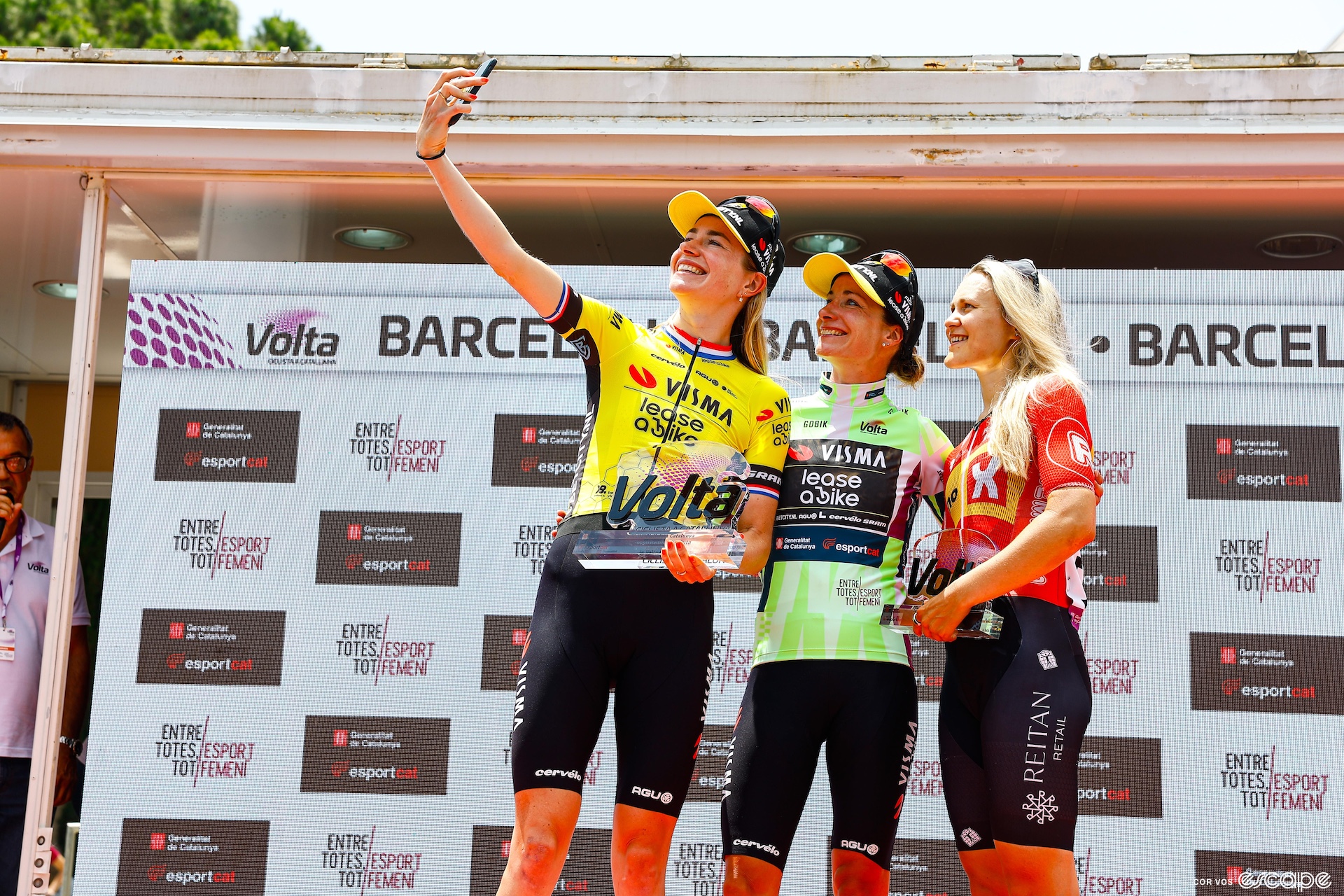
Racing Continues…
At Tour de Suisse!
The fourth edition of the women’s Tour de Suisse kicks off on Thursday and the hilly four-day event promises to deliver some fantastic battles, with a lot of riders using the race as a test before both the National Championships and the Giro d’Italia.
The first two editions were won by Lizzie Deignan and Lucinda Brand before the race joined the WorldTour calendar. Last year it was an SD Worx-Protime affair, with Blanka Vas winning the first stage, Marlen Reusser the second, and Niamh Fisher-Black the fourth and final stage. Only Eleonora Gasparrini (UAE Team ADQ) could get around the Dutch team’s blockade with her victory on the third stage.
It would be easy to look ahead to this year’s race and think the four days will again be scooped up by SD Worx-Protime. The team has won nearly every WT stage race so far this year (except the Tour Down Under); they’ve even swept all the stages of two of the five races. But a few top riders are returning to the peloton after a break and we have every reason to believe this will be the race SD Worx-Protime will really have to fight to win.
The Basics
When: June 15th – 18th
Distance: Three road stages, one individual time trial. 327.4 km total
Live coverage: 🇪🇺 Eurosport/Discovery+, 🇺🇸 MAX, 🇨🇦 FloBikes, 🇳🇿 StayLive
Stage 1 @ 10:50 CET, Stage 2 @ 10:30 CET, Stage 3 @ 15:00 CET, Stage 4 @ 15:00
The Course
Stage 1: Saturday, June 15 – Villars-Sur-Ollon (58.6 km, 1,529 m)
The last two editions have started with short stages, both under 60 km, both multiple circuits of a hilly course. This year the race will once again start with a short first stage, but instead of circuits the 58.6 km route covers two ascents with a total elevation gain of 1,529 meters. That wouldn’t be a lot of climbing if the course was 100+ km, but at sub-60, it’s going to be a fast, brutal stage.

Break out the trainers ladies, because the climbing starts from the gun. The first ascent is 8 km long, averaging 6.3% with maximum grades of 12%. The official start to the climb is about 2 km into the stage, but in reality, it starts even earlier.

The final climb serves as the finish as well; labelled as a 7.3 km long climb averaging 8.2%, the climb is more like 12 km in length with a gradual lead-in to the real deal. The max on this second ascent is almost 13% at the base, meaning any pressure leading into the climb or early on will see major cracks before the bulk of the climb even starts.
Stage 2 ITT: Sunday, June 16 – Aigle to Villars-Sur-Ollon (15.7 km, 865+ m)
The second stage is an individual time trial which starts at the Centre Mondial du Cyclisme UCI, aka the UCI’s headquarters. The time trial is short, only 15.7 km, but is one of the very few WT-level ITT events available to the women. Unfortunately for the ITT specialists, it’s basically a hillclimb.

The first 6 km are flat, with a few turns. Very straightforward simple ITT stuff. But the final 10-ish km go straight uphill. The climb averages 7.9% with 11.8% max, grades that could even see some riders changing bikes. It’s a course that is Taylor-made for the swiftest of the Swiss riders and last year’s winner: Marlen Reusser. Unfortunately, Reusser won’t be there; she’s a late DNS due to an infection.

Stage 3: Monday, June 17 – Vevey to Champagne (125.6 km, 1,993 m)
The third stage is the first true road stage – 125.6 km long with almost 2,000 meters of elevation gain over four categorized climbs and a few uncategorized ascents thrown in for good measure.

Like the first stage, the climbing starts when the race does, with the first Cat 2 climb only 5 km from kilometre 0. It’s a 1.2 km ascent only but with sections of 12% it’s enough to hurt. The two Cat 3’s that sit in the middle of the stage are not that challenging: the first is almost 5 km in length averaging 4.7% and the second only 1.6 km long with a 5.1% average. They will test the peloton and wear down the legs before the final Cat 2 climb that tops out 10 km from the finish.

This final ascent will be where the general classification riders and anyone hoping to win the stage will start their games. With a downhill run to the finish, anyone who lost time in the second stage will have an opportunity to take back some seconds and the leading team may find it hard to control the final 10 km to the line after the ascent.
Stage 4: Tuesday, June 18 – Champagne circuit (127.5 km, 2,124 m)
The final stage is the hardest on paper, with two Cat 2 climbs, the first 11.4 km long averaging almost 5%, and the second 5.3 km with an average of 4.7%, it’s a fantastic last course for anyone to take the jersey.

Warming up for the stage should seem normal by Sunday, and once again the riders will start climbing around 10 km into the stage. The first climb is the longer of the two and will see the peloton break apart, but there is a long stretch of flat that includes two short, uncategorized climbs where riders can chase to regain contact. The second climb is not as long or as steep and tops out with 45 km remaining in the stage so it’s not necessarily the end of the road. There is plenty of room after that second climb for teams to chase and the cards to shuffle.

The Contenders
After some time away from the peloton a few top riders will return to racing for the Tour de Suisse. Demi Vollering returns after winning all three Spanish stage races. Even without Reusser the team is a formidable one with Niamh Fisher-Black and Mischa Bredewold. But it’s a real bummer the Swiss champ won’t be present.
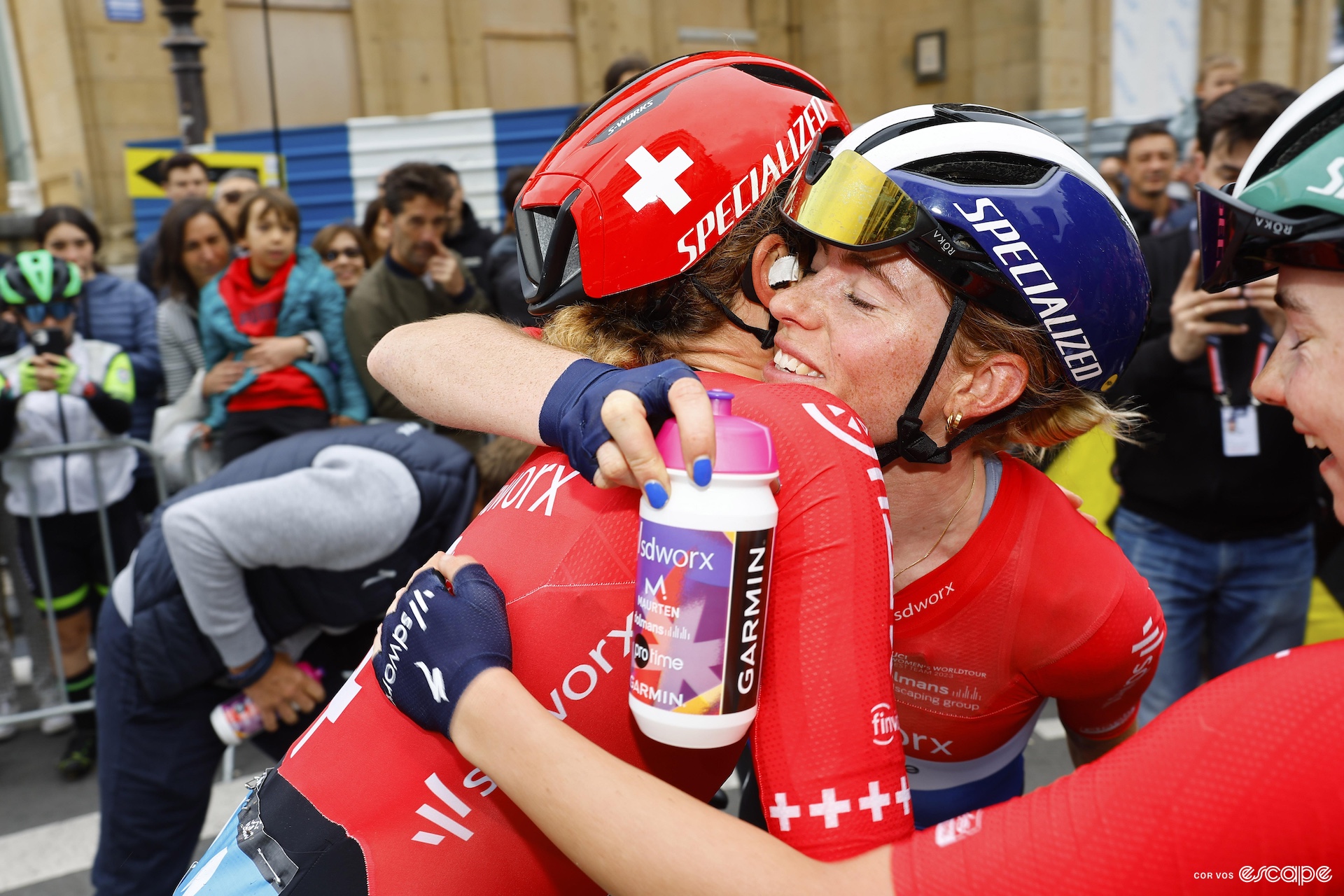
Kasia Niewiadoma (Canyon-SRAM) will return to racing as will Elise Chabbey. Both riders have stepped it up this season and after her performance, a La Fleche Wallonne Niewiadoma in particular will be one to watch. Neve Bradbury is also back in action for the team.
Lidl-Trek brings with them Elisa Longo Borghini, who hasn’t raced since the Vuelta España Femenina, as well as Gaia Realini. Plus they’ll have 2022 Tour de Suisse winner Lucinda Brand.
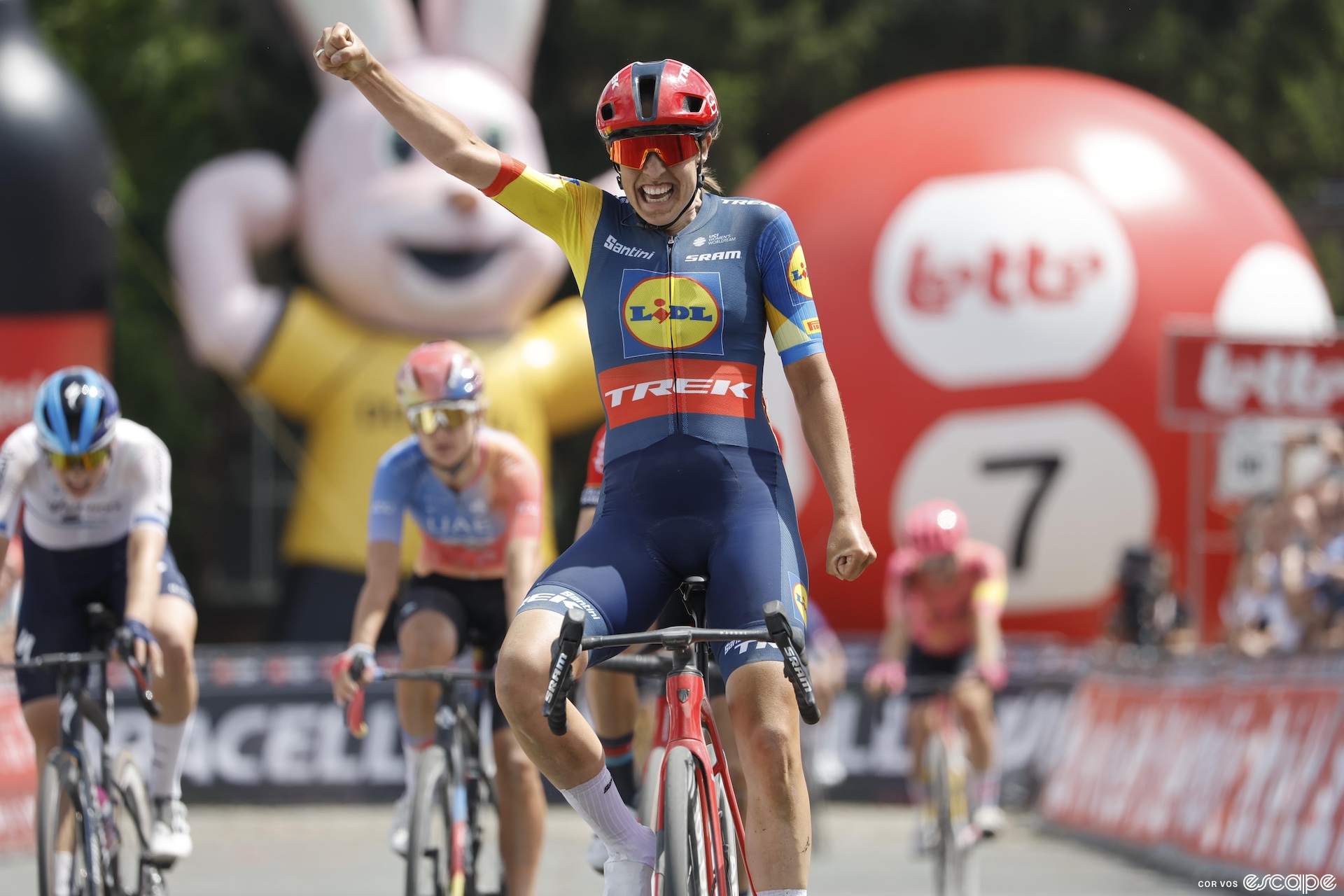
For FDJ-Suez, Évita Muzic will, it seems, be sitting this one out while Amber Kraak and Marta Cavalli take the reins.
Pfeiffer Georgi is listed on the provisional start list alongside Megan Jastrab, but it would be surprising if DSM-Firmenich PostNL didn’t bring Juliette Labous.
Visma-Lease a Bike has Marianne Vos and Fem van Empel but no Riejanne Markus (subject to change).
For UAE Team ADQ we’re looking at Lizzie Holden, Dominika Włodarczyk and possibly even Erica Magnaldi.
And finally, for EF Education-Cannondale, Kristen Faulkner will debut her USA national jersey alongside Kim Cadzow (who recently announced a contract renewal with the American team) and Veronica Ewers.
Australia’s Conti team ARA-Skip Capital is on the start line (shoutout to Matilda Raynolds), as is Team Bridgelane. And then there are the familiar Conti teams: VolkerWessels, St Michel-Mavic-Auber93, and Tashkent City who just got tapped to race the Giro d’Italia.
Check back here for a full startlist ahead of the race on Saturday.
Wheel Talk Podcast
This week Abby is joined by Matilda Raynolds and a very special guest – Shawn Clarke, DS for Liv AlUla Jayco. They chat about Tour of Britain, how teams decide which DS goes to which race, the transfer market, and more.
Obsessions: Abby – Fall Guy, Shawn – Tour de Gatineau and Bike Race Ottawa, Tils – Timeshifter app
As mentioned, we are conducting a listener survey to improve this and our other Escape Collective podcasts. You can find it here.
Let’s Discuss
WorldTeams skipping WorldTour races.
From when the UCI first formed the Women’s WorldTeams structure it was never in the rules that all the teams with WWT status were required to race all the WorldTour races. One of the reasons was budget, another the size of teams, but it’s become pretty normal to see teams sitting out a WWT race every once in a while.
Normally, it’s not a big deal. So Visma-Lease a Bike sits out a one-day race or two? But when only four WorldTeams line up to a WorldTour race while five of the others opt to race a 2.1 happening at the same time, it’s a bit more of an issue, for multiple reasons. One is that the WorldTour event had to put in a certain amount of investment to make their race comply with the UCI’s WorldTour standard (for example, providing a minimum amount of live coverage). Another concern is the presence of so many WorldTeams at a lower-level race takes away from the development opportunities of Continental teams.
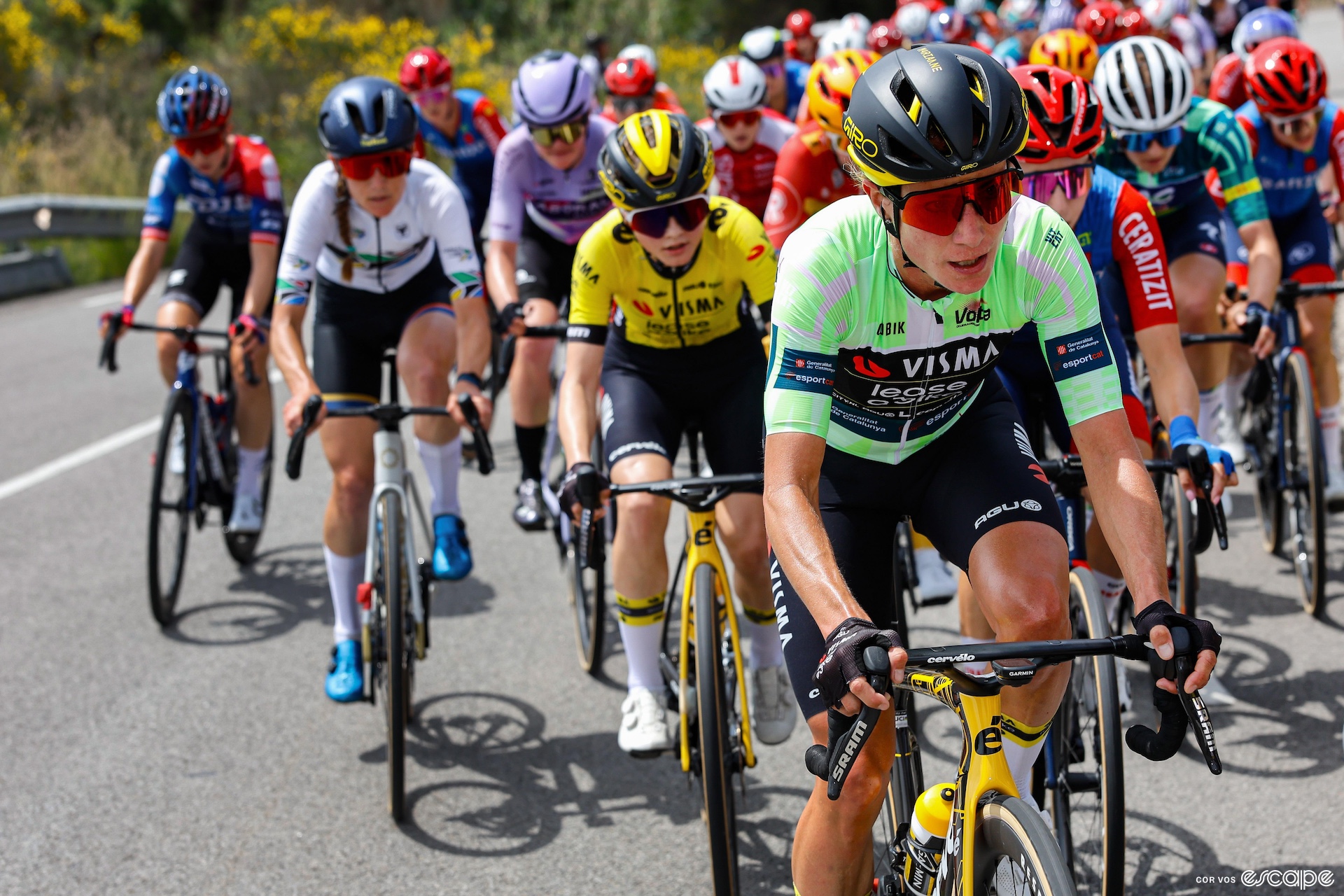
According to riders on the ground at Volta a Catalunya, which had five WorldTeams present including Visma-Lease a Bike, Movistar and AG Insurance-Soudal, the race was “WorldTour speed,” but half the peloton were Continental teams that never raced a WorldTour race all season.
This has its pluses and minuses. Of course, those developing riders get to line up with Marianne Vos, which is pretty cool. They get to experience a higher level of racing than they would have and get a taste of what their careers could be like in the future. But it also takes away opportunities from riders who need to be able to fight for a win to develop their skills.
In the past, these lower-level races were not as fast as the top level, but not by leaps and bounds. These days, the level of women’s cycling is always rising, but there is a growing gap between the WorldTour and the Continental teams in terms of both funding and skill. That applies to the teams but it also applies to the races. Where the Continental teams used to be able to at least keep up with WorldTour teams at these races, now they are only trying to survive.
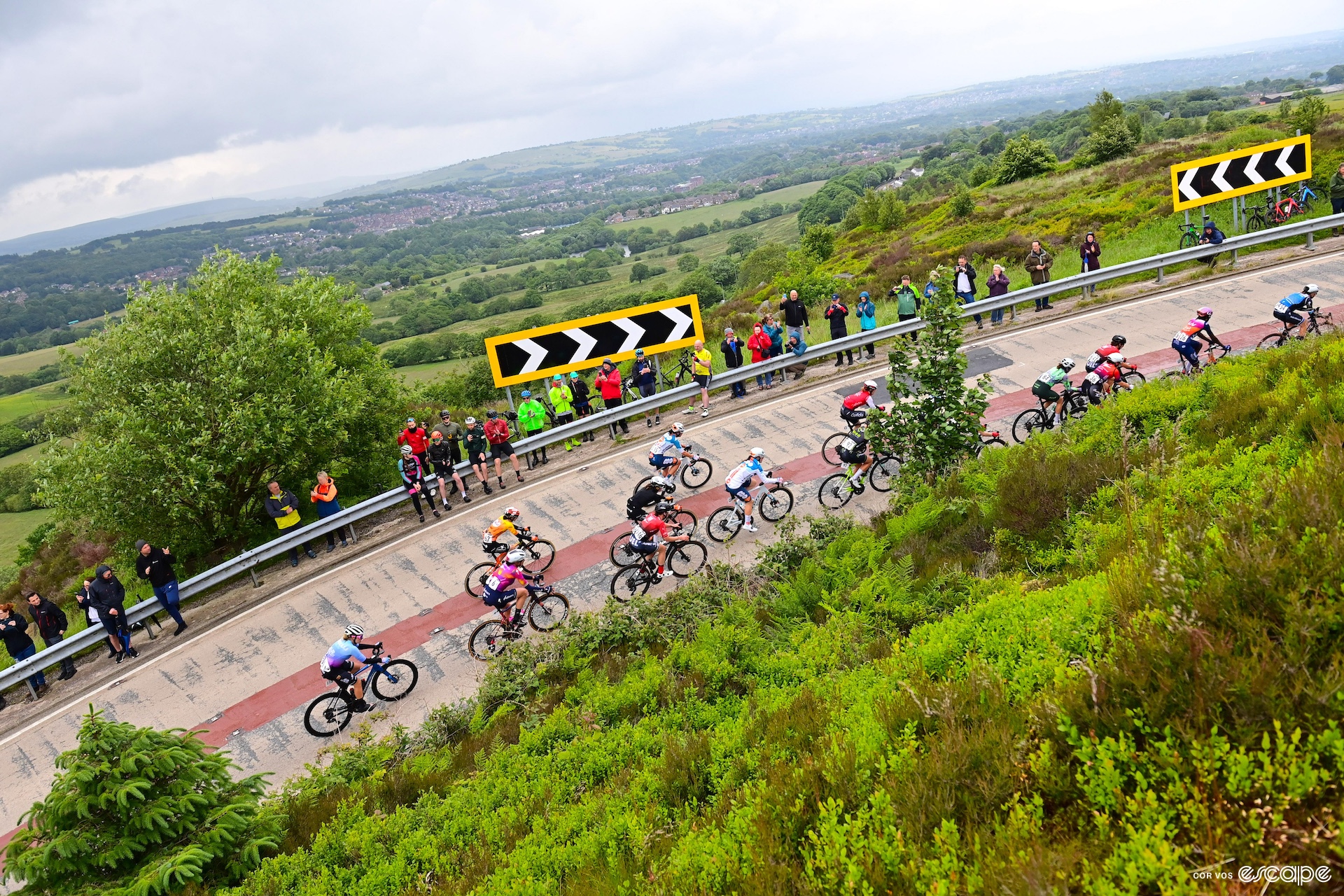
Then there’s the issue of investment by the WorldTour races. Imagine you spend all this time and money to throw a party and you’ve set everything up against all odds, but then none of the VIPs show up. The Tour of Britain, against all odds, happened this year. It was close to shutting down but they ended up pulling off a pretty good four-day race. The best part of the whole thing was start-to-finish live coverage of every stage; not even the Tour de France Femmes does that. So then to only have four WorldTour teams rock up to the start is pretty disappointing.
There were, of course, circumstances outside of some teams’ control. Brexit was thrown around as a reason. But we had FDJ-Suez, Lidl-Trek and Canyon-SRAM all racing RideLondon just a few weeks earlier and none came back for the Tour of Britain.
Stepping away from semantics, it’s just kind of a bummer to see.
There’s always some good that comes out of it. The Continental teams that raced the Tour of Britain were able to fight for some WorldTour results, for example. But when it comes to WorldTour racing, don’t we want to see the top teams competing at the top level?
Picture worth a couple of words
Ruby Roseman-Gannon said after she won the final stage at the Tour of Britain that it was a bittersweet victory. Sweet for the win, of course, but the entire peloton would celebrate a Christine Majerus victory. One of the most dedicated and selfless riders in the peloton, it’s not often Majerus gets to take a win herself. But timing is everything and … you gotta keep moving forward.
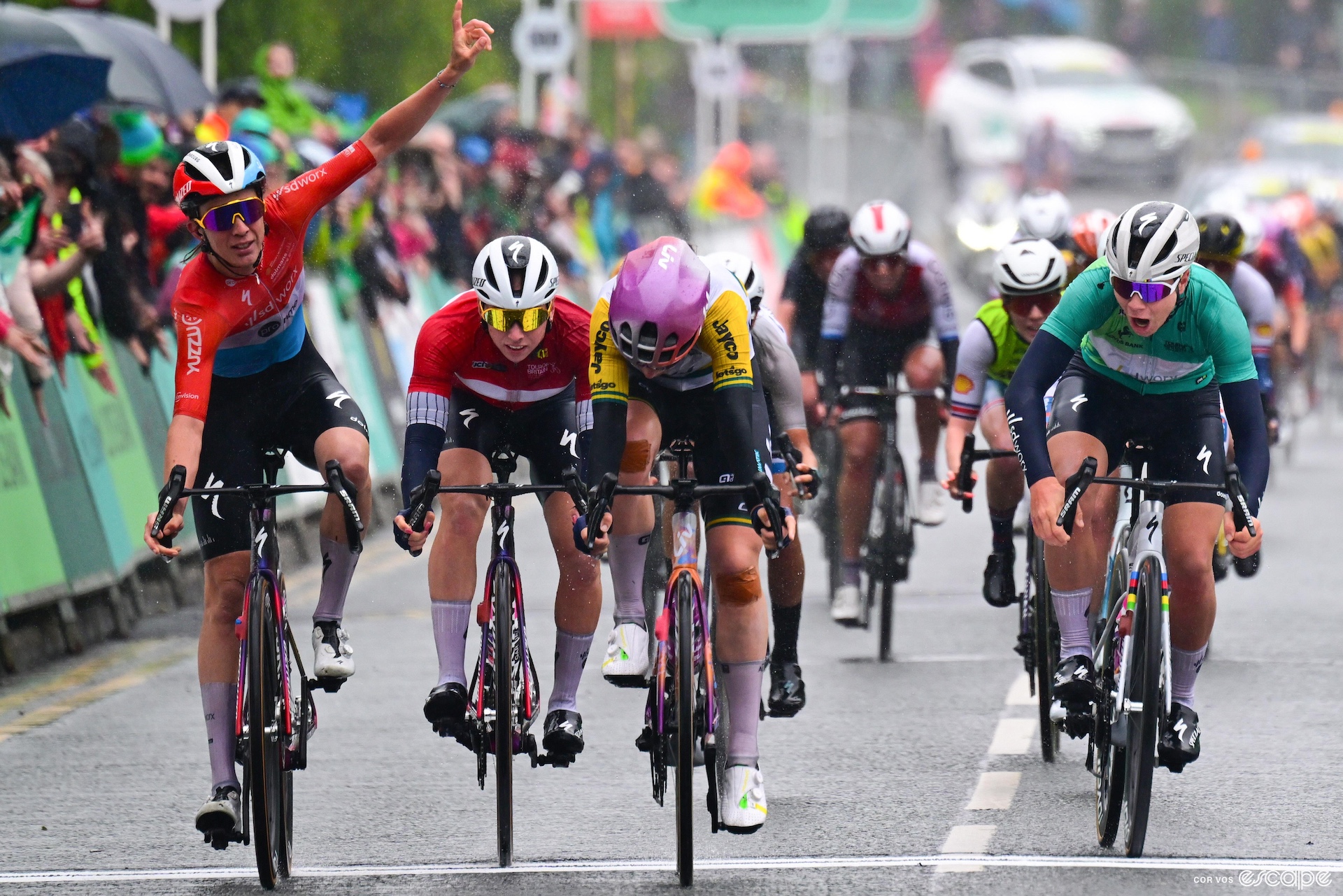
Kopecky’s face says it all. This picture is definitely worth a few words.
Taylor Swift
Fact: Sabrina Carpenter knows how to write a catchy song.
For her newest single Please Please Please, Carpenter worked with long-time Taylor Swift producer Jack Antonoff and co-writer Amy Allen. It is the second song (after the absolute BOP Espresso) off Carpenter’s next album “Short n’ Sweet” to be released August 23.
Until next time!
Three final bits of news to close us off.
ONE: Pauline Ferrand-Prévot is leaving her mountain bike on the wall and returning to road racing, allegedly with Visma-Lease a Bike. The former road world champion currently races for Ineos Grenadiers as a solo MTB rider, so can any rumours of the British team starting a women’s outfit finally be put to bed?
The Frenchwoman formerly rode for Canyon-SRAM as part of a multi-discipline project but quit the road to focus on MTB in 2020 (in theory earlier, her last road race besides the 2019 and 2021 French national championships was La Course by the Tour de France in 2018, where she didn’t finish).
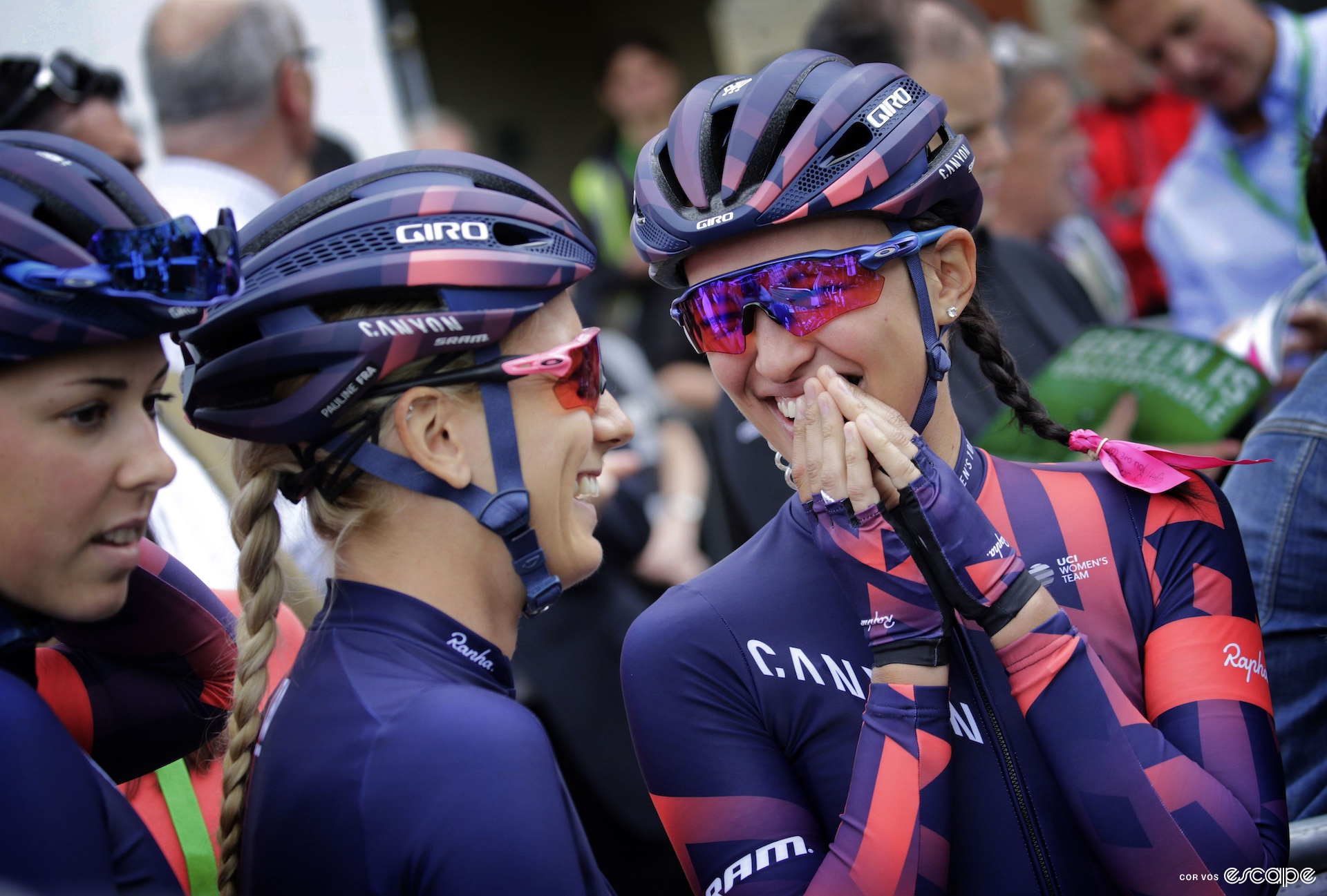
Her deal is rumoured to be a three-year contract and will see her join Marianne Vos and Fem van Empel to strengthen both the road and stage racing teams.
TWO: Lidl-Trek announced over the weekend that Ellen van Dijk was involved in a training accident that resulted in a fracture to her right ankle. Along with her trade team, the Dutch federation has put forward a recovery plan that should allow the former ITT world champion to race the Olympic Games as planned, but of course, more will be known after her surgery is complete.
“Of course, I am incredibly disappointed,” Van Dijk said in a statement. “All my efforts are focused on the Olympics, and this is the last thing you want to happen. I am in good hands with the medical and performance staff of both Lidl-Trek and the KNWU, and we will do everything we can to ensure I am fit at the start in Paris.”
If there’s anyone who would be mostly unphased by a broken ankle this close to the biggest race of her season (after having a baby) it’s Ellen van Dijk.
THREE: I saved the best for last. The Tour de France Femmes avec Zwift announced on Monday that they will expand the race to nine stages in 2025, with the Grand Départ taking place in Brittany. More info can be found here thanks to Dane Cash.
Thank you for reading this week’s Wheel Talk Newsletter. I will be back next week with more from the world of women’s cycling, but if you have any questions or topics you want to discuss you can find me on the Escape Collective Discord.
What did you think of this story?
